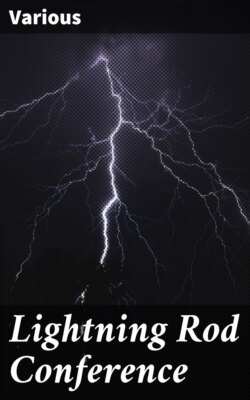Читать книгу Lightning Rod Conference - Various - Страница 5
На сайте Литреса книга снята с продажи.
Class of Facts most Required.
ОглавлениеTable of Contents
Full details of accidents by lightning, stating especially whether the building struck had a conductor or not. If there was a conductor, state its dimensions—construction—mode of attachment to building—whether its top was pointed—distance of its upper terminal from the place struck—nature and extent of the connection between the conductor and the earth, and whether the earth was dry or moist—whether the conductor was itself injured—and whether the conductor or the point struck was the most salient object in the vicinity. Information is also desired, either verbally or by sketches, as to the position of metal spouting and lead roofing relatively to the point struck, and to the conductor.
Details of the thickest piece of metal melted by a flash of lightning are much needed.
Unimpeachable evidence of the failure of conductors is much desired, as such failures would be extremely instructive.
The replies were by no means as numerous as was expected: the most important will be found in Appendix I.
At the meeting, October 27th, 1879, it was resolved “That the members of the Conference will undertake to prepare abstracts of the principal English and Foreign books upon Lightning Conductors.” This work became extremely heavy, and occupied much time, as will be seen from Appendix F, which contains abstracts of sixty separate treatises, of which 26 are from English, 17 from French, 6 from Belgian, 5 from American, and 5 from German authors, and one is from the Norwegian.
In order to guard against omitting important works, it was resolved “That application be made to the Society of Telegraph Engineers for advance sheets of the Ronalds Catalogue.” From it, supplemented by Mr. Latimer Clark’s and other lists, the Secretary compiled Appendix G., which contains the full titles of no fewer than 704 separate works upon lightning conductors, or on subjects intimately connected therewith.
At the same meeting it was resolved that efforts be made to obtain a set of the official instructions issued in all foreign countries. The circular issued, and an abstract of the information collected, including replies from America, Belgium, Denmark, Germany, Holland, India, Italy, and Norway, will be found in Appendix H. Full details respecting the practice in France will be found in Appendices F, K, and L, and a notice of Zenger’s Austrian system, on p. (104).
At the meeting, Nov. 20th, 1879, the Secretary was unanimously requested to act as Editor of the Report.
At the meeting, Jan. 22nd, 1880, a letter was received from Mr. R. H. Scott, F.R.S., Secretary to the Meteorological Council, enclosing a report respecting the injury to the “Southern Queen,” it was resolved, “That some of the delegates visit the ship.” The report and a note of the results of the visit will be found in Appendix I page (205).
At the meeting, April 15th, 1880, Prof. D. E. Hughes was unanimously elected member of the Conference.
At the meeting, July 6th, 1880, the Secretary handed in a sketch of a house with various parts of the lightning conductor marked upon it, and obtained from the delegates definite names for each portion, in order that in framing the report there might be no uncertainty as to what was meant by any special term, great confusion in this respect having previously existed.
The terms adopted have been: Conductor.—The whole arrangement for the protection of a building. Point.—The upper termination of the conductor, whether blunt or sharp, single or bifurcated. Upper terminal.—That portion of the conductor which is between the top of the edifice and the point. Joint.—Any connection between any two parts of the conductor. Rod.—The main portion of the conductor, whether it consist of rope, tape, tube or solid rod. Circuit des Faîtes.—A rod running round the eaves of a house, the battlements of a tower, &c. Earth plate.—The termination of the conductor in the ground, the pattern being indicated by special terms.
The accompanying lithograph will, it is hoped, supply all additional necessary particulars.
It is desirable to state that the illustrations in this Report have been prepared by Mr. E. White Wallis, F.M.S., so as to bring out the various features distinctly, and as nearly as possible in true proportion, but without any attempt at artistic finish.
The meetings during the latter part of 1880, and the early part of 1881, were devoted chiefly to the discussion of various questions as bases for the report. Much time was also occupied in perfecting the various appendices, and in compiling an exhaustive index to them.
In May, 1881, Messrs. Preece and Symons, being in Paris, made careful enquiries as to the existing practice in France respecting lightning conductors. Their notes form Appendix K.
At the meeting held on May 27th, 1881, the Secretary was instructed to draw up a draft report, and this having been put in type was sent to all the delegates; carefully considered, revised, and amended at various subsequent meetings, and finally adopted.
INDEX SKETCH OF LIGHTNING CONDUCTOR, ILLUSTRATING THE TERMS EMPLOYED IN THE REPORT.
| TERMS APPLIED TO THE VARIOUS PARTS OF A CONDUCTOR. | |
|---|---|
| Crutch | |
| Strap | |
| Staple | |
| Wall Eye | |
| A | Point |
| B | Upper Terminal |
| c | Joint |
| D | Rod |
| E | Ridge Rod |
| F | Circuit des faîtes |
| G | Earth Plates |
| G1 | Earth Plates Sanderson |
| G2 | Earth Plates Borrel |
| G3 | Earth Plates Spang |
